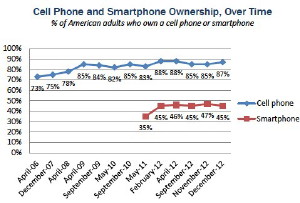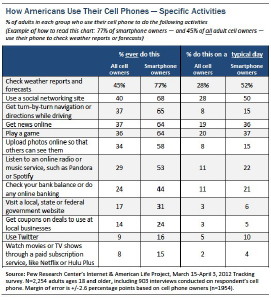Special Reports
Catching Up with Our Mobile Society
 Not there yet? Here are a few things to think about en route.
Not there yet? Here are a few things to think about en route.
As mobile media continues its steady explosion across all forms of 21st-century communication, we in the performing arts realm often feel like we have been suddenly plopped into the technological equivalent of the Wild West. Opportunities for customer engagement via mobile are vast, but what exactly are they? Where, when, to whom, and with what content do we push “send” when the options for “receive” range from tiny mobile screens to Jumbotrons?

The numbers for mobile use are ever-rising: According to a Pew Internet study, as of December 2012, about 87% of American adults owned a cell phone and 45% owned a smartphone. GroupofMinds’ 2012 survey [see Arts Patrons: Mobile Preferences | 2012] indicates that about 80% of arts consumers own smartphones, and 70% of them use their phones to look up arts events. A year ago, half of adult smartphone owners were using their devices to access the Web, nearly double the amount Pew found three years earlier. And over 30% are apt to use their phones in lieu of their computers.

“It’s hard to conceive of how quickly the mobile revolution has come. It was here long before we were really ready for it,” says Lara Koch, manager of online technology for the Humane Society of the United States. “A lot of nonprofits are scrambling to catch up.”
Making sure mobile is included in the marketing mix is imperative; stick with traditional tactics like snail mail at your peril. “If you can’t communicate with people the way they would like to communicate, you’re going to have a problem,” says Allison Krumm, digital marketing manager for the Mann Center for the Performing Arts in Philadelphia. “Technology is going to continue to evolve, people will evolve, and you have to cater to that.”
Where to begin?
But where do organizations begin with mobile-particularly when budgets are tight?
Step One: Total immersion
John Kenyon, a nonprofit technology educator and strategist, suggests that performing arts organizations develop a mobile strategy by putting aside their desktops for a day and using only their smartphones to get a feel for what their web site and emails look like on the devices. “Total immersion is a good place to start,” he says. “Go back and check the emails you’ve sent out over the last few months on an Apple and Android device and see how they look. If your email isn’t readable, people are not going to click through to your web site.”
 Step Two: Check the receiving end
Step Two: Check the receiving end
Koch of the Humane Society points out the importance of using web site analytics to get a clear picture of what devices people are using when they visit the sites, thereby catering their offerings to the majority of users.
“I do not only a breakdown of overall mobile traffic, but also by device to get a picture of who visits our site,” she says. “You don’t want to take the plunge (with new technology) unless you’re getting the visits to warrant the work.”
Step Three: Make it pithy
In crafting a mobile-friendly web site, Kenyon suggests examining the regular desktop-accessed site to determine what information is appropriate for mobile. If you are catering to people on the go with less time to linger, strip the information down to the essentials, think about what they might need while out and about: information about events, how to purchase tickets, directions, parking, etc.
“The mobile web site is the Reader’s Digest version of the whole site,” Kenyon says. “You want to think about the most popular pages. The place for me to read the bio of the artistic director is not necessarily on the mobile device. I would leave the story about the history of the organization to the regular web site.”
The ideal mobile web site should be engaging and informative, should load quickly, and should avoid use of images and other rich media that are going to slow things down or create unnecessary clutter on small screens.
For an in-depth look at the options in creating a mobile presence, see Going Mobile: The Options.
And if all else fails
Lacking the resources for responsive design or mobile sites, take baby steps by creating a basic, no-frills mobile-friendly landing page.
“Just so they can learn who you are in a way that fits on their device,” says Koch.
In addition to reaching out through mobile, organizations should also consider allowing audience members to use smartphones during performances, says Koch, even encouraging picture taking and sharing them on social media networks.
“It used to be that organizations didn’t allow pictures in a theater because they don’t want people stealing their stuff. But sharing information and photos on social networks is a piece of the performance now,” Kenyon says. “These organizations know that if I see pictures of a great performance, I’m more likely to go than if I just read a review somewhere.”
There are many considerations when allowing smartphones into the theater: See Mobile Media in the Concert Hall: Who’s Doing It and Who’s Not.
Emails
For emails, Kenyon suggests limiting the word count with a mobile audience in mind. “You don’t want to give people 500 words in an email that they’re going to access on a mobile device,” he says. “You should be brief and to the point.”
Then, when they click through to a web site, they go from “getting a teaspoon of information to getting a tablespoon.”
Text Messages
Text messaging is another means of connecting with users on mobile. Kenyon suggests reserving texts for events and other information that are time-sensitive, such as a notification that auditions are coming up or that an artist has cancelled and a substitute has been installed.
“Phones are very personal and intimate, so if you’re sending text messages asking for money out of the blue, it might not be seen as appropriate,” Kenyon says. “You need to really think through what you send in a text.”

Dina Gerdeman is an award-winning reporter and editor with nearly 20 years of experience. For the past three years, she has worked as a freelance writer and editor, developing content and editing copy for Web publications such as CMO.com; Harvard Business School’s online publication; Health Resources In Action, a Boston nonprofit organization; and TechTarget.





 FEATURED JOBS
FEATURED JOBS

 RENT A PHOTO
RENT A PHOTO


